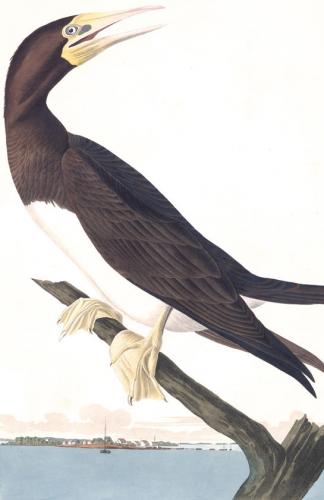In the Background

If the birds are the central fact of The Birds of America, the images in the background of the plates can provide insight into Audubon’s project and its aims. The plates of The Birds of America include many varieties of contextualizing images: prey animals like fish, mice, and insects offer information about birds’ habits and appetites; local flowers and trees as well as detailed landscapes allow viewers to understand birds’ habitats and their larger environment; anatomical details and diagrams provide scientific precision. The human landscape in the distance behind the Booby Gannet—an island community of houses and a church, docks and moored sailboats—can be identified as one of the Florida Keys. Because we know that as many as one half of Audubon’s subscribers were European it seems likely that, in addition to showing the bird in its habitat, this kind of background detail serves as a kind of travelogue providing views of the distant and exotic American landscape. By contrast, the Frigate Pelican appears on a largely blank page, with no landscape features—close-up details of the top and bottom of the bird’s foot are the only additional visual element. This plate reminds us that, regardless of its enormity The Birds of America served its first readers as a naturalist’s guidebook, a distant descendant of our pocket field identification guides. A reader of this copy has annotated the margin with the numbers of plates in Volume 4 of The Birds of America.
The plates on view feature birds Audubon likely collected and painted in the Florida Keys in 1832.
ON VIEW: Volume III (Copy 2): Plate CCVII (207) – Booby Gannet & Volume III (Copy 1): Plate CCLXXI (271) – Frigate Pelican
Booby Gannet (Plate 207)
From Ornithological Biography, or, An Account of the Habits of the Birds of the United States of America, by John James Audubon, 1831-49
I am unable to find a good reason for those who have chosen to call these birds boobies. Authors, it is true, generally represent them as extremely stupid; but to me the word is utterly inapplicable to any bird with which I am acquainted. The Woodcock, too, is said to be stupid, as are many other birds; but my opinion, founded on pretty extensive observation, is, that it is only when birds of any species are unacquainted with man, that they manifest that kind of ignorance or innocence which he calls stupidity, and by which they suffer themselves to be imposed upon. A little acquaintance with him soon enables them to perceive enough of his character to induce them to keep aloof. This I observed in the Booby Gannet, as well as in the Noddy Tern, and in certain species of land birds of which I have already spoken. After my first visit to Booby Island in the Tortugas, the Gannets had already become very shy and wary, and before the Marion sailed away from those peaceful retreats of the wandering sea-birds, the Boobies had become so knowing, that the most expert of our party could not get within shot of them.
READ Audubon’s complete text at Audubon.org
Frigate Pelican (Plate 271)
From Ornithological Biography, or, An Account of the Habits of the Birds of the United States of America, by John James Audubon, ,1831-49
See him now! Yonder, over the waves leaps the brilliant dolphin, as he pursues the flying-fishes, which he expects to seize the moment they drop into the water. The Frigate-bird, who has marked them, closes his wings, dives toward them, and now ascending, holds one of the tiny things across his bill. Already fifty yards above the sea, he spies a porpoise in full chase, launches towards the spot, and in passing seizes the mullet that had escaped from its dreaded foe; but now, having obtained a fish too large for his gullet, he rises, munching it all the while, as if bound for the skies. Three or four of his own tribe have watched him and observed his success. They shoot towards him on broadly extended pinions, rise in wide circles, smoothly, yet as swiftly as himself. They are now all at the same height, and each as it overtakes him, lashes him with its wings, and tugs at his prey. See! one has fairly robbed him, but before he can secure the contested fish it drops. One of the other birds has caught it, but he is pursued by all. From bill to bill, and through the air, rapidly falls the fish, until it drops quite dead on the waters, and sinks into the deep. Whatever disappointment the hungry birds feel, they seem to deserve it all.